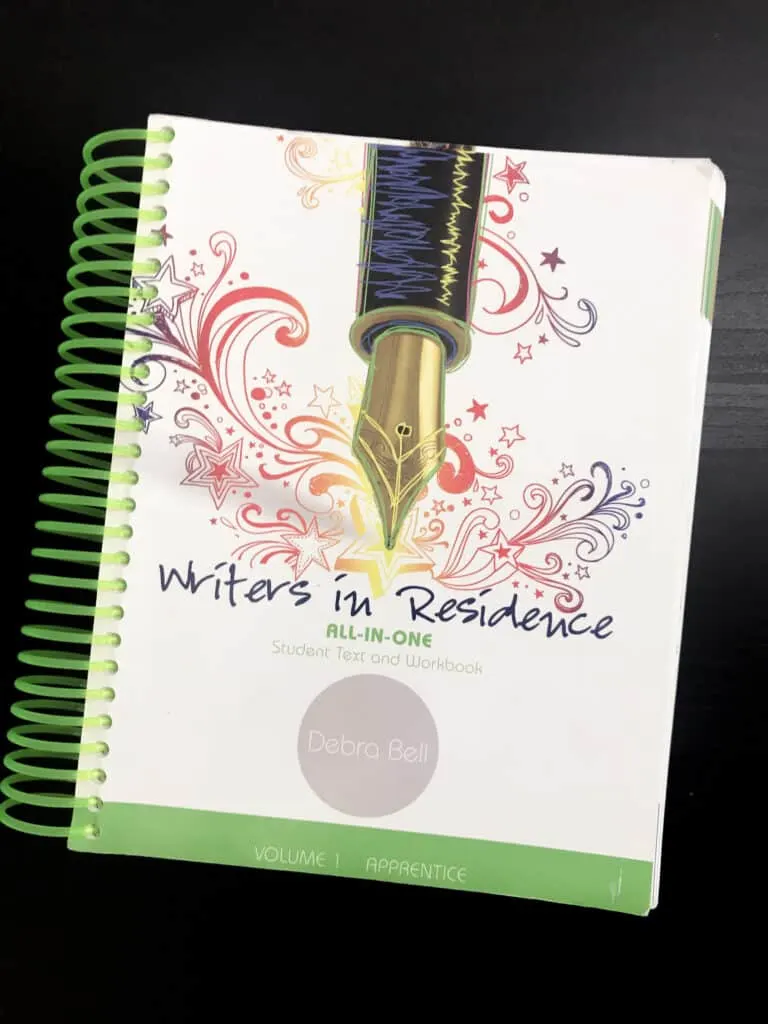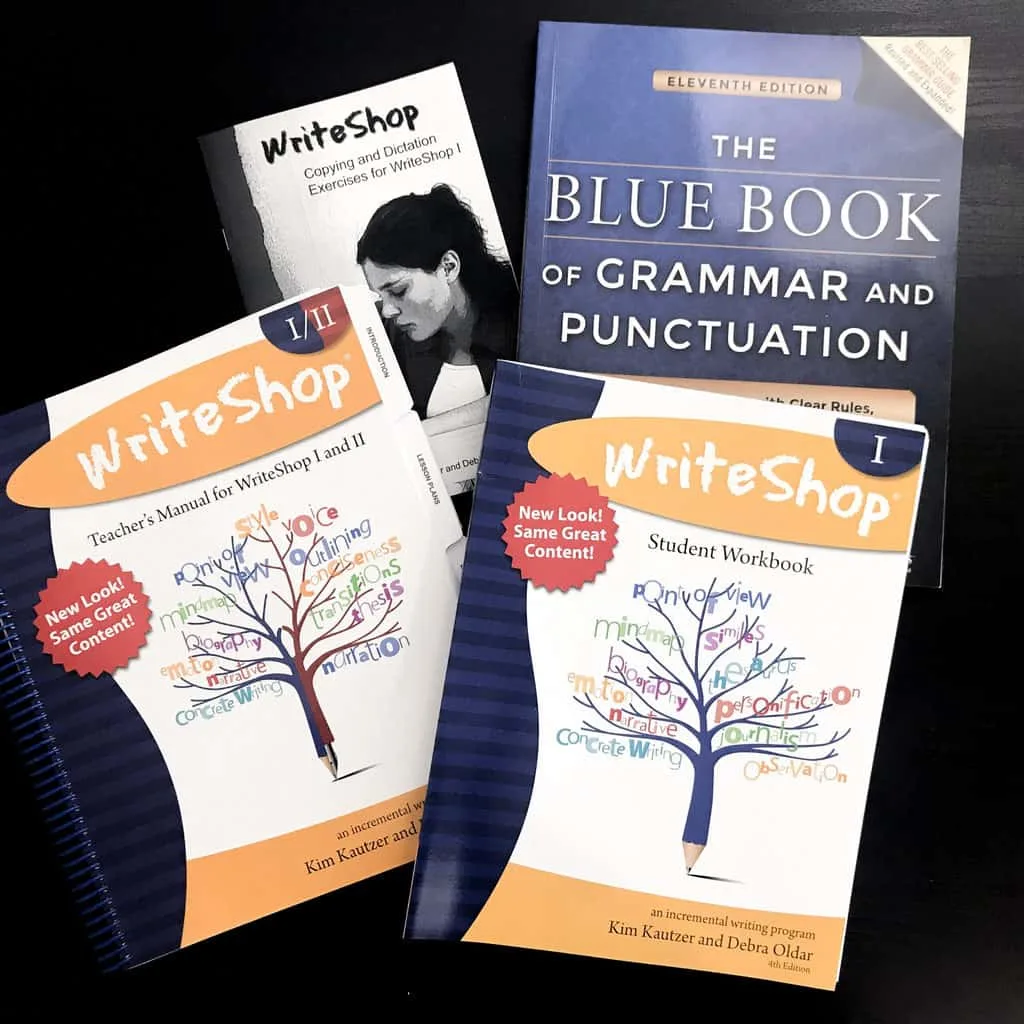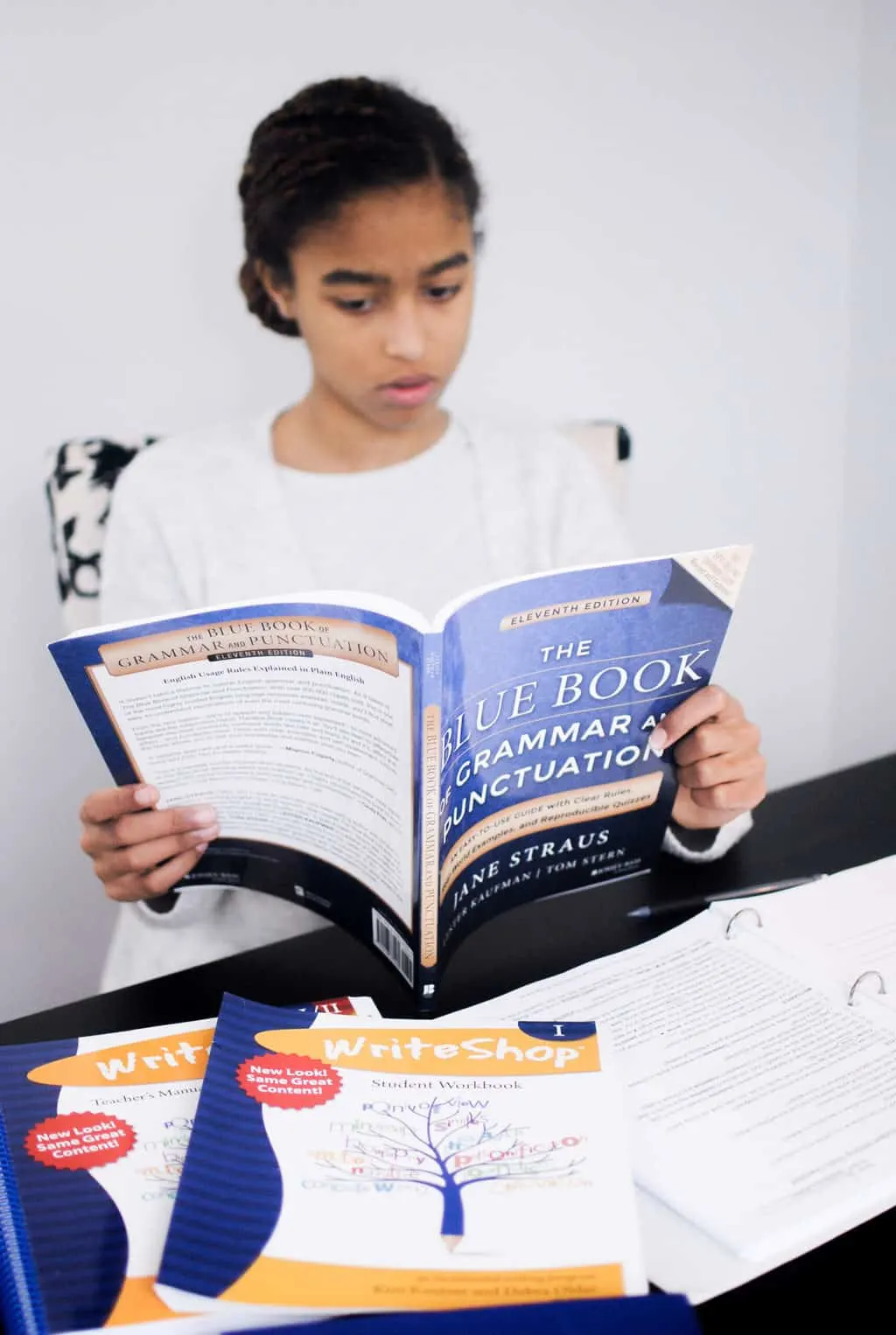As a family of writers, we set the bar pretty high when we evaluate writing curricula for our homeschool. Your choice of writing programs can make a huge different in how much your kids enjoy learning about writing. In this post we compare two of our favorite middle school writing curriculum programs: Writers in Residence and WriteShop I/II by Kim Kautzer and Debra Oldar.
I received a free copy of the WriteShop 1 Starter Bundle for review purposes and I was compensated for my time. All opinions are my own and I am not required to post a positive review.
Updated on April 30, 2021: At this time, publication of Writers in Residence has been suspended. Deeply discounted copies of volumes 1 and 2 can still be purchased from Christian Book Distributors.
Over the past few years, we have used both the Writers in Residence series by Debra Bell and the WriteShop program developed by Kim Kautzer and Debra Oldar.
Each of these writing programs provides students with a solid and comprehensive foundation for learning to write without boring or intimidating them. But which one is best for your homeschool?
Read this comparison review to help you determine the best option for your family.
WriteShop I/II vs. Writers in Residence: Comparison Overview
In this review of two top homeschooling writing programs, I’ve tried to answer all the main questions a parent might have when trying to select a homeschool writing curriculum for middle grade students. If you have additional questions about either WriteShop I/II or Writers in Residence, please leave a comment below and I’ll address it.
You can click on these links to jump to any section of the comparison:
- Main objective of each homeschool writing curriculum
- Age ranges
- Using the writing program with multi-age groups
- Parent prep time
- Average lesson time
- Types of writing assignments
- Curriculum length
- Extras
- Faith component
- Pricing
The main objective of each homeschool writing curriculum
Writers in Residence Homeschool Writing Curriculum Overview

In Debra Bell’s Writers in Residence, students learn about sentence structure, the parts of speech, and the conventions of the English language for punctuation, capitalization, and usage. They complete six writing assignments and develop an ongoing superhero narrative. Students use models from professional writers to construct their own writing assignments.
Writers in Residence is built on the six traits writing model and teaches a five-step writing process: planning, drafting, revising, editing, and polishing.
Please note: in this review I’ve only evaluated Writers in Residence Volume 1: Apprentice as I have not personally used Volume 2: Journeyman, which may be more on par with WriteShop I in terms of content.
WriteShop I/II Homeschool Writing Curriculum Overview

WriteShop I/II is an incremental homeschool writing curriculum authored by Kim Kautzer and Debra Oldar. This program offers high school students and upper-middle graders a solid foundation in descriptive, informative, and narrative writing, and teaches them self-editing skills.
WriteShop I helps them refine their writing and pay better attention to content and grammar while teaching and reinforcing the elements of writing style. Students learn to write from observation and experience. Once they know how to write more concretely and concisely, they can move seamlessly into WriteShop II.
What Ages Are These Writing Programs Aimed At?
The Writers in Residence series is a writing-focused language arts program designed for 4th grade to 8th grade, though it’s especially effective for middle school students. I have tried it with a couple of fourth-graders and it was too much work for them.
WriteShop I/II can be used for an even wider variety of age ranges and ability if small adaptations are made. The average seventh to tenth grader student can jump into WriteShop I readily.
Particularly bright and motivated fifth and sixth graders may also be able to tackle the Writeshop curriculum with additional parental support. For high schoolers lacking a strong writing foundation, WriteShop I is also the best place to start.
WriteShop II offers expanded lessons for eighth to twelfth graders, introducing advanced descriptive narration and essay writing, including the timed essay.
The creators of the program typically don’t recommend WriteShop II as a starting point except for high schoolers who already have a strong writing foundation and who have reviewed the fundamental concepts taught in Lesson 1.
Can Writeshop I/II and Writers in Residence Be Used to Teach Writing in a Multi-Age Group?
Writers in Residence
Writers in Residence can be taught simultaneously to kids of different ages and varying abilities. I have successfully used it in a co-op with students ranging from grades 4 to 7, though I had to modify it some for the younger students.
If working with multiple children, be prepared to spend more one-on-one time with younger/newer writers. Older or more advanced writers should be able to complete most of the assignments independently.
When working with younger students, be sure to adjust your expectations. There are a lot of questions in the Writers in Residence curriculum.
What I often do when working with a group is have them write answers to one question and then do the next one as an oral discussion. If we get behind, we might skip one or two questions if I feel the kids have grasped the concepts being taught.
When working with a group of kids, use it as an opportunity to teach the importance of receiving feedback on their writing. Every writer needs readers who will read early drafts of their work and offer insight into what needs to be modified.
For example, if several readers are confused by the same sentence, the writer may want to consider editing that sentence for clarity.
WriteShop I/II
WriteShop I/II is designed with the “average” seventh to tenth grader in mind. Particularly advanced fifth or sixth-grade writers may be able to use the program with increased parental involvement.
Although much of the work is intended to be completed independently, most students will still benefit from a lot of one-on-one interaction with the parent-teacher, particularly when it comes to giving feedback.
Certainly, the format of WriteShop I/II is such that you can use it with a group of multi-age students if they are within the age range specified above and are capable of moving at relatively the same speed.
One way to do this would be to introduce each new lesson to the students as a group and then have them work independently. The parent-teacher would then proofread and edit all assignments before working with each student one-on-one to discuss the strengths and areas of opportunity in their writing.
Depending on the group, this feedback could be discussed altogether, though many kids aren’t comfortable having their writing discussed in front of others. Group discussion should focus on the areas of improvement that are relevant to most or all of the group.

Alternatively, more advanced students might be able to take on more of the lessons independently while you spend extra time with those who have further to go in their development as a writer.
Whichever curriculum you choose, keep in mind that individualized feedback is essential to helping kids improve their writing, so you will want to balance the number of students you’re teaching with the amount of time you have for working one-on-one, bearing in mind the learning styles of each child and the amount of attention they’re likely to need.
Try to avoid having more advanced students sitting around waiting for others to catch up or rushing a struggling student in order to keep pace with a sibling.
Learning to write, like learning any other skill, doesn’t occur at a set pace. Everyone will develop on their own path.
Prep Time
There is zero prep time with Writers in Residence unless you decide to preview the material in advance, which the author does recommend.
The directions for each assignment are clear and straightforward and no outside materials or resources are required.
Likewise, there is essentially no prep work with WriteShop I/II. For each lesson, the Teacher’s Manual includes step-by-step instructions for preparing and teaching, checklists, suggestions for addressing problem areas, and tips for editing, evaluating, and grading student compositions.
There are checklists for editing and answer keys to Skill Builders and pre-writing activities.
While the prep time for each program is minimal, neither middle school writing curriculum can be completed independently.
One of the most important components of learning to write is receiving feedback and suggestions for improvement.
At the very least, you’ll need to invest time reading, editing, proofreading, and evaluating your student’s compositions.
In my experience, though, these homeschool writing programs are most effective when I sit with my kids throughout and make sure they’re staying on track and fully comprehending each lesson.
With a self-motivated high schooler, you may be able to decrease your involvement, but the students to whom I’ve taught writing, ranging in age from five to twelve, have all required more attention and input than I might have expected.
All that to say, you can expect to spend a fair amount of time teaching your kids to write, but it won’t be spent prepping if you select either of these homeschool writing programs.
Lesson Time
When following the prescribed schedule for Writers in Residence, lessons usually take 20-60 minutes. When I teach it in a group, we only work on it together once a week, so we spend about an hour and a half, but the kids do some of the work at home for homework in between co-op sessions.

I should note that the lessons almost always take longer than I think they will. Younger kids usually write pretty slowly. Give yourself some margin so you don’t feel rushed to finish it exactly when you planned to.
With WriteShop I/II, you can plan to spend anywhere from five minutes to one hour or more per day. This depends not only on the day’s activities, but on your student’s maturity, motivation, and attitude.
Most students complete one full writing assignment every two weeks (4-7 hours per lesson).
What Types of Writing Assignments Will My Kids Do?
Writers in Residence
There are four types of writing assignments in the Writers in Residence writing curriculum:
- I remember: These writing prompts ask students to write about experiences they have had. They are primarily personal narratives.
- I imagine: These writing prompts are high-interest creative writing assignments. Students study expert models of fiction closely and learn to include the elements of fiction in their own stories. They develop the ability to draw on their own memories and experiences as inspiration for the stories they weave.
- I investigate: These writing prompts introduce research skills and research writing. Field research and interviews are introduced as essential sources of information. Students learn to detect bias in their sources and in their own writing.
- I think: These writing prompts teach students the fundamental elements of argument writing. They learn to take a position and defend it with logical reasoning, facts, and apt examples.
WriteShop I/II
In WriteShop I/II, the focus is on mastering the art of writing paragraphs by choosing vivid, descriptive words and using sentence variations. Students work primarily on paragraph development before moving on to informative, narrative, and persuasive writing.
Many of the assignments are no longer than two to three paragraphs, giving students the opportunity to build mastery on a foundation level before attempting to produce longer compositions and reports.
Assignment types include:
- Various types of descriptions: an object, a pet, a person, a circus performer, a food, a season, and a place.
- Explaining a process.
- Writing a factual paragraph.
- Writing a concise biography.
- Writing a news article.
- Writing a short report.
- Various types of essays.

How Long Will It Take to Complete These Writing Programs?
Writers in Residence includes a detailed weekly schedule that allows you to complete the program in 32 weeks using a 4-days-per-week format.
WriteShop I/II offers three tracks. Teachers can choose to have students complete the program in one, two, or three years.
The two-year track is the standard pace and is recommended for most seventh to ninth graders as well as bright and motivated sixth graders and tenth/eleventh graders who need help mastering the concepts of writing a paragraph.
The three-year track allows for extended practice and/or remediation and is recommended for younger students (fifth-seventh grades) or older students who don’t have a strong writing foundation).
The one-year track offers an accelerated pace for “bright, highly motivated older students) who love to write.” This track requires that writing become a priority for the school year, as students will spend five or more hours per week on their writing assignments.
The Teacher’s Manual guides teachers in choosing the correct path(s) for their student(s) and then offers a one or two-week schedule based on the chosen plan. For the average student in the two-year track, each lesson should take two weeks to complete.
What Extra Features Are Included or Available?
Writers in Residence
Writers in Residence offers an all-in-one student text and workbook. There is no separate parent manual as all instructions and necessary info is included in the combined text/workbook.
When using the book with multiple students, you can purchase one main book and additional student workbooks that contain just the assignments, rather than the complete text.
You can also purchase a separate answer key, which provides directions, checklists, and an evaluation rubric for every writing assignment that takes the guesswork out of evaluating your child’s writing.

WriteShop I/II
WriteShop I/II comes with lots of additional activities, resources, and features to help you provide your student(s) with the most robust writing curriculum possible. Here are some of the resources and extras you can expect:
- Separate Teacher’s Manual, which includes:
- A comprehensive guide to editing and evaluating student writing, including a writing skills checklist
- Suggestions for positive and encouraging comments to offer in your feedback
- A section on addressing common errors in each lesson
- Student writing samples
- Supplemental activities to help students fully master concepts (for use with the two and three-year tracks only)
- A mini-thesaurus for student reference
- Suggested essay topics
- Video companion course: The creators of WriteShop I/II teamed up with PlayWith.Education to offer a video companion course if you’re short on time for explaining concepts or don’t feel comfortable doing so. Each module corresponds to one lesson and has a brief (about ten minutes) video for each aspect of the lesson.
- Optional upgrades to have tutors grade and/or edit student assignments.
- When you purchase the course as a bundle, you receive the Teacher’s manual for both WriteShop I and II, the WriteShop I student book, a copy of the Blue Book of Grammar & Punctuation, Copying & Dictation Exercises, and an 8.5″ x 11″ poster of WriteShop’s writing process.
Faith Component
Both Writers in Residence and WriteShop are Christian products.
Writers in Residence provides a biblically-based framework for kids to think about language and communicate effectively in writing. The text includes interviews with Christian authors.
While not overtly religious, some WriteShop I and II materials do contain occasional religious references. They are minimal and can easily be skipped or even changed to suit your own needs.
(Update, April 2020: WriteShop has just released a faith-neutral 5th edition of WriteShop I and II. They are discontinuing the faith-based 4th edition.)
Pricing
Writers in Residence
Writers in Residence, which was previously published by Apologia, is currently out of print. You can still buy it from Christian Book Distributors at a great price while supplies last.
WriteShop I/II
Several purchase options are available including teacher’s manuals, classroom handbooks, and ebook bundles. The pricing below is current as of January 12, 2023.
WriteShop I Student Workbook – $62
WriteShop I and II Bundle (2 workbooks and the teacher’s manual) – $187
WriteShop I Start Bundle – $121
Which Middle School Writing Curriculum Is Right for You?
Ultimately, I don’t think you can go wrong with either of these homeschool writing programs. It all comes down to personal preference, learning styles, and readiness of your children. I have found Writer’s in Residence to be a very useful writing curriculum for younger middle schoolers, particularly reluctant writers.
WriteShop I/II builds on a lot of the concepts introduced in Writer’s in Residence and would be a good follow-up if you used Writer’s in Residence in the early middle grade years. It’s a thorough program that will provide a robust writing education for older kids over the course of one to three years.

Sophie Agbonkhese is a writer, homeschooling mother of four, and a recovering overachiever (who occasionally relapses). She is the founder of My Cup Runs Over, a site dedicated to helping busy women simplify and enrich their lives. When she’s not writing or debugging websites, Sophie spends her time reading, dancing, bullet journaling, reading, gardening, listening to audiobooks, and striving fruitlessly to have a clean house for at least five minutes.
